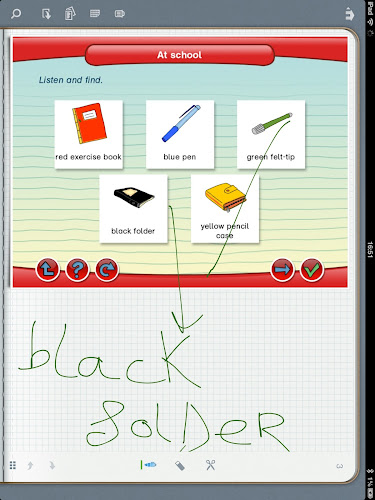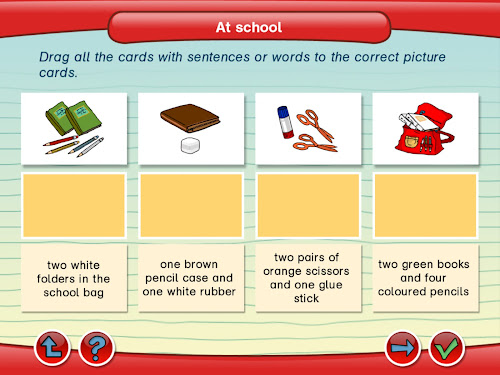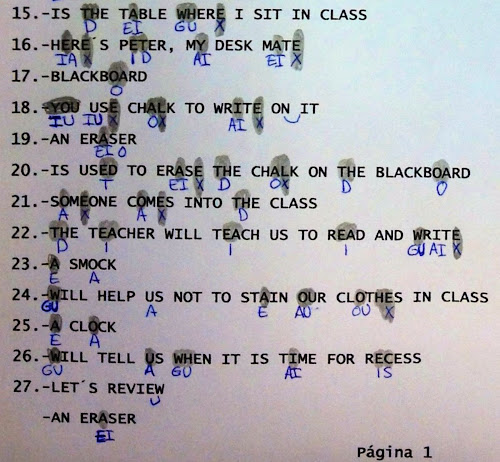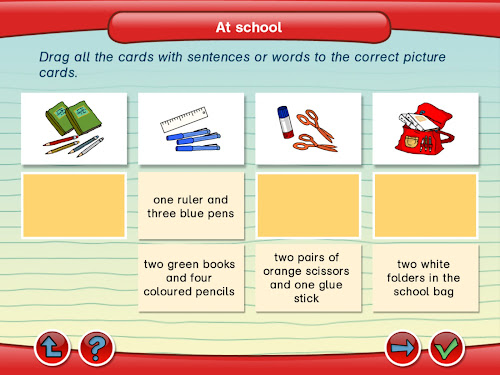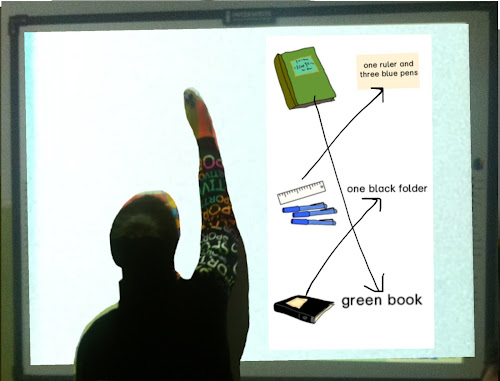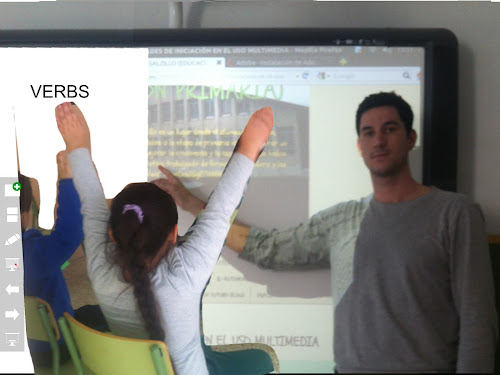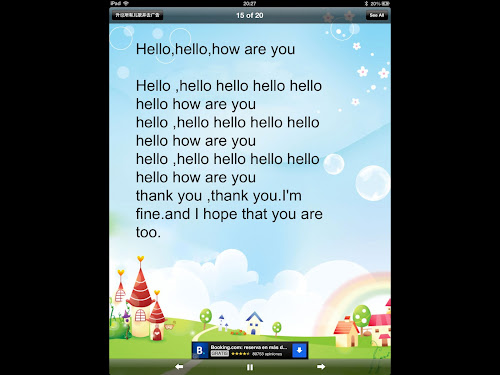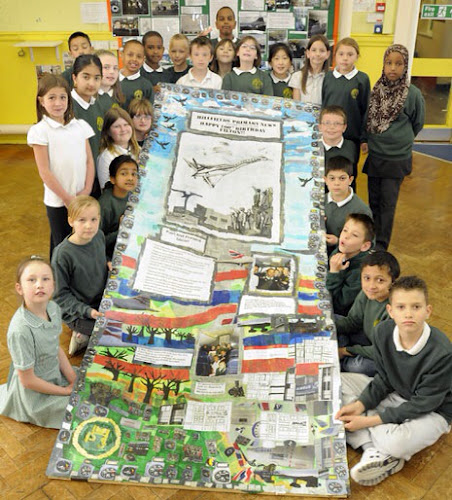El blog de primaria del Colegio Salzillo es un lugar donde el alumnado, familias, maestros y otros miembros vinculados a la etapa de primaria van a encontrar un lugar de encuentro con objeto de mejorar la motivación y participación escolar, pilares del éxito escolar en los que todos podemos cooperar.
Páginas
- INICIO
- EXPLICACIÓN DEL BLOG
- 1.-COMPETENCIA EN COMUNICACIÓN LINGUÍSTICA
- 2.-COMPETENCIA MATEMÁTICA
- 3.-COMPENTENCIA EN EL CONOCIMIENTO Y LA INTERACCIÓN CON EL MUNDO FÍSICO
- 4. TRATAMIENTO DE LA INFOR. Y COMPETENCIA DIGITAL
- 5.-COMPETENCIA SOCIAL Y CIUDADANA
- 6.COMPETENCIA CULTURAL Y ARTÍSTICA
- 7.-APRENDER A APRENDER
- 8.-AUTONOMÍA E INICIATIVA PERSONAL
- 9.-COMPENTENCIAS EMOCIONALES
- CONTENIDOS A TRATAR POR LAS TARDES
- INFANTIL (POSIBILIDAD DE FUTURO BLOG)
- DOCUMENTO DE MEDIDAS DE MEJORA DEL BLOG
lunes, 29 de abril de 2013
domingo, 28 de abril de 2013
ENSAYO FINAL DE 5º Y 6º E.P."BODAS DE LA PULGA Y EL PIOJO"
viernes, 26 de abril de 2013
USO DE KEYNOTE (POWERPOINT) PARA MEJORAR LA LECTO-ESCRITURA
Un simple Ipad hace las veces de pizarra digital, en vez de usar programas como Interwrite un simple powerpoint con imágenes de textos tradicionales, ha sido contrastado positivamente en la mejora de la lecto-escritura del alumnado de la etapa de infantil.
miércoles, 24 de abril de 2013
TALLER ASTRÓMICO 5º Y 6º PRIMARIA
1ª SESIÓN:A TRAVÉS DE LA PDI, HEMOS VIAJADO POR EL ESPACIO, VISUALIZANDO CONSTELACIONES, PLANETAS, ...
DE FORMA VIRTUAL COMO SI DE UN TELESCOPIO SE TRATARA, NOS ORIENTAMOS POR EL ESPACIO (OSA MAYOR, OSA MENOR, POLO NORTE,...). INSTALA Y VISITA LAS APLICACIONES:
El firmamento estelar
El planetario
2ª SESIÓN: CONSTRUIMOS UN PLANISFERIO CELESTE INDIVIDUAL
3ª SESIÓN : FILM "FURIA DE TITANES"
4ª SESIÓN: REPASO. EN EL AULA PLUMIER
5ª SESIÓN: PLANISFERIO EN EL TECHO DEL AULA DE 5º Y 6º DE PRIMARIA
martes, 23 de abril de 2013
domingo, 21 de abril de 2013
UN NUEVO RINCÓN PARA EL HUERTO ESCOLAR DEL SALZILLO
 |
| NUESTRO CONSERJE DON RAMÓN INSTRUYENDO A LOS ALUMNOS EN CONOCIMIENTOS AGRICOLAS |
LOS ALUMNOS DEL SALZILLO, CON LA MISMA ILUSIÓN,SI CABE MÁS, ALIMENTARON POR SEGUNDA VEZ LA TIERRA DE CULTIVO, CON PLANTON DE CALABACÍN, PEPINO, TOMATES,...APORTANDO UNA SONRISA A CADA ESFUERZO.
TODOS LOS MIÉRCOLES LOS ALUMNOS DE 5º Y 6º DE PRIMARIA SE ACERCARÁN AL HUERTO PARA REVISAR SU CRECIMIENTO Y REGAR LAS PLANTAS.
MUY PRONTO OTRAS ACTIVIDADES SERÁN OBJETIVO DE ACERCAMIENTO DE LOS ALUMNOS AL HUERTO.ALGUNAS COMO: MEDICIÓN DE SU CRECIMIENTO, ETIQUETAR LAS PLANTAS, DECORAR ESTE RINCÓN,ETC.
ADEMÁS, LOS ALUMNOS HAN PLANTADO SEMILLAS DE MELÓN, SANDÍA, CALABAZA,...EN UN GRAN SEMILLERO, PARA SU POSTERIOR UTILIZACIÓN EN EL HUERTO.
ENSAYAMOS LA DRAMATIZACIÓN DEL CUENTO "LAS BODAS DE LA PULGA Y EL PIOJO"
 |
| COMIENZA EL CUENTA CUENTOS |
 |
| EL MOSQUITO ES UN GRAN PERCUSIONISTA;) |
 |
| EL LOBO TAMBIÉN AYUDARÁ EN LA CELEBRACIÓN |
 |
| NUESTRA LOGOPEDA SUPLENTE DE UNO DE LOS ALUMNOS.UNA GRAN MAESTRA DE LA INTERPRETACIÓN |
 |
| EN ESTE ENSAYO HIZO DE NOVIA.ELLA ES CAPAZ DE INTERPRETAR CUALQUIER PAPEL: MADRINA, HORMIGA...¡GRACIAS SONIA, ERES UNA ARTISTAZA, DE LOS PIES A LA CABEZA!¿QUÉ HARÍAMOS SIN TÍ? |
martes, 16 de abril de 2013
BIBLIOTECA DEL COLEGIO (LIBROS QUE PUEDE CONSULTAR EL ALUMNADO)
RELIGIÓN
MÚSICA
MATEMÁTICAS
LENGUA
INGLÉS
FRANCÉS
EDUCACIÓN FÍSICA
CONOCIMIENTO DEL MEDIO
AUDICIÓN Y LENGUAJE
ESTRUCTURA DE SESIÓN GRADUANDO LA PARTICIPACIÓN ACTIVA DEL ALUMNADO (EN INGLÉS) PARA MANTENER CONSTANTE LA PARTICIPACIÓN Y MOTIVACIÓN DEL DISCENTE ANTE EL DISCENTE MÁS DESMOTIVADO Y POCO PARTICIPATIVO (TRANSFERIBLE A CUALQUIER ÁREA)
1.-NORMAS DE CLASE: El docente comenzará preguntando si consideran que un acto u otro es correcto o no. (Este será el único apartado que se realizará en español). El alumnado reflexionará:
A.-QUÉ HA PASADO
B.-ACTOS NEGATIVOS
C.-ACTOS POSITIVOS
D.-PREGUNTAR CUAL SERÍA LA SOLUCIÓN CORRECTA
E.-CONTRASTE DE IDEAS ENTRE EL ALUMNADO
2.-CANCIONES (YOUTUBE) CANCIONES EN INGLÉS MOTIVANTE PARA EL ALUMNADO Y DE FÁCIL REPRESENTACIÓN CORPORAL
A.- Realizamos fotos sobre vocabulario, gramática ...propia de la unidad didactica y lo copian.
B) Han de escribir con el bolígrafo las "Parts of Speech" "Vocabulary" o "Morphosyntactic elements"
4.-PHONICS (SELECCIONAN ENTRE DOS OPCIONES POSIBLES DIFERENCIANDO ENTRE DOS SONIDOS) (APP PHONICS BASIC, NO PROBLEM)
5.-VOCABULARIO Y GRAMÁTICA (MÚLTIPLES OPCIONES) (APP ÉXITO EN PRIMARIA)
6.-PUZZLES (App InfinityPuzzles)
Ordenan las piezas en su sitio. Cuando la colocan correctamente la escuchan y han de repetirla. Los puzzles están categorizados por temáticas
7.-FICHAS EN FORMATO PAPEL (Dejamos autonomía al discente)
Corregimos con la APP PENULTIMATE EN LA PIZARRA (previamente hacemos una foto a la ficha). Así se corrige simultánea y cláramente a todos sin excepción.
8.-JUEGOS EDUCATIVOS TIPO TRIVIAL
viernes, 12 de abril de 2013
IDEAS EN LA COMUNICACIÓN CON MADRES Y PADRES (Jesús Martínez)

"Se ha demostrado que la colaboración de los padres con los maestros a propósito de una acciónde interés común, la educación de los niños, favorece su desempeño y su rendimiento escolar, sean cuales sean las características de dicho centro". Fuente:
ALMEIDA, J. (1990): Consideraciones sobre la intervención de los padres en la escuela. En Educación y Sociedad.No 6.
APPLE, M. y BEANE, J. (1997): Escuelas democráticas. Ed. Morata. Madrid.
BOLÍVAR, A. (1999): Educar en valores. Una educación de la ciudadanía. Junta de Andalucía. Sevilla.
BELTRÁN, F. (1999): La inevitable necesidad de la participación en la escuela pública. En Revista EnfoquesEducacionales. Vol. No 1. No 2.
BERNAL Y OTROS (1997): Participación, gestión e ¿ideología? En GARAGORRI, X. Y MUNICIO, P.:
Participación, autonomía y dirección. Ed. Escuela Española. Madrid.
BLASE, J. (1991): The politics of life in schools. Sage. Newbury Park.
BOZAL, V. (1977): Una alternativa para la enseñanza. Centropress. Madrid.
CEPRIÁN, B. (1991): Del Consejo de Instrucción Pública al Consejo Escolar del Estado. Origen y evolución (1836-1986). UNED. Madrid.
DÉNIZ, A. Y DOMÍNGUEZ, H. (1998): “El programa Escuela-Familia: Una experiencia de apoyo institucional a larelación escuela-familia”. En Conceptos. No 3.
DURKHEIM, E. (1975): Educación y sociología. Ed. Península. Barcelona. Escuelas y
FEITO, R. (1992): La participación de los padres en el control y gestión de la enseñanza. Departamento de
Sociología III. Facultad de Ciencias Políticas y Sociología. Universidad Complutense. Tesis Doctoral.FERNÁNDEZ ENGUITA, M. (1990): La escuela a examen. Eudema. Madrid.
FERNÁNDEZ ENGUITA, M. (1993): La profesión docente y la comunidad escolar: crónica de un desencuentro.Ed. Morata. Madrid.
FERNÁNDEZ ENGUITA, M. (1994): El parto de los montes. En Cuadernos de Pedagogía. No 224.
FLECHA, R. (1998): El aprendizaje es participación social. En CONCEJO: La participación social como eje
educativo. Reflexiones y experiencias. XX Escuela de Verano. Valladolid.
GINER, S. (1996): Carta sobre la democracia. Ari. Barcelona.
GIROUX, H. (1993): La escuela y la lucha por la ciudadanía. Ed. Siglo XXI. Madrid.
GÓMEZ LLORENTE, L. y MAYORAL, V. (1981): La escuela pública comunitaria. Ed.. Laia. Barcelona.
MARTÌN MORENO, Q. (1996): Desarrollo organizativo de los Centros educativos basado en la comunidad. Ed.Sanz y Torres. Madrid.
MARTÍNEZ BONAFÉ, J. (1998): Democracia en la escuela como investigación del currículum. En MARINEZBONAFÉ, J.: Trabajar en la escuela. Miño y Dávila Editores. Madrid.
MARTINEZ BONAFE, A. (Coord.) (1999): Viure la democràcia a l ́escola. Carpeta de Treball. Graó.
MARTINEZ RODRÍGUEZ, J.B. (1997): Evaluación de la participación en los Centros Escolares. Ed. Escuela
Española. Madrid.
MAYORDOMO, A. (Coord) (1992): Estudios sobre participación social en la enseñanza. Servei de Publicacions dela Diputació de Castelló. Castelló.
MORGAN, Images of Organization. Sage Publications. Beverly Hills.
RODRÍGUEZ ROJO, M. (1993): Asociación de Padres y participación comunitaria. En LORENZO, M. y SÁENZ,
O.: Organización Escolar. Una perspectiva ecológica. Ed. Marfil. Alcoy.
RUBIO CARRACEDO, J. (1996): Educación moral, postmodernidad y democracia. ed. Trotta. Madrid.
Algunas ideas de Jesús Martínez para favorecer la implicación de las familias atendiendo a las características del CEIBas Salzillo desde la etapa de primaria:
-Eventos de interés periodístico. Un boletín aula es la herramienta perfecta para dejar saber a los padres todo lo que sucede en el aula. Utilizamos un formulario combinado con el talento de escritura de los estudiantes para producir una revista para padres para disfrutar de por ejemplo, lo que estamos aprendiendo, noticias de los estudiantes, próximos eventos, qué hay de nuevo en torno a la escuela. Cada semana se asignará a cada boletín un
tema diferente. Animamos a los estudiantes a que entrevisten a sus compañeros, hablan con el secretario de la escuela o se consulta con los miembros del personal de la escuela para obtener información sobre su tema. Después editamos el artículo de cada estudiante y se copia la información en un boletín formal. Después duplicamos y distribuimos copias de aula para que los estudiantes lo lleven a casa y lo compartan con sus familias.
-Se busca: Voluntarios.
Recordamos a los padres que ellos son una parte muy importante del proceso de aprendizaje invitándolos a ser voluntarios para diversas tareas en el aula (por ejemplo, acompañante de excursiones, asistir a los estudiantes en la biblioteca, preparar proyectos de arte, organizar partidos de clase, mini olimpiadas, ayuda para el suministro de materiales para proyectos especiales (ejemplo: recortes de revistas), leer un cuento en la clase, compartir una habilidad o información con la clase, ayudando en el trabajo con
los estudiantes en clase, creamos un tablón de anuncios. Incluso si los padres trabajan, pueden ser capaces de asumir algunas de las responsabilidades enumeradas.
-La caja recurso. Establecer un rincón de la clase al que pueden echar un vistazo. En el que pueden proveer de flashcards, reproducibles, libros de lectura, juegos. Se les informará con una hoja que pueden visitar el colegio en una hora concreta.
-El maravilloso trabajo de fin de semana: Facilitar un diálogo padres/hijo(a) en el que cada viernes se les da a los padres una serie de preguntas que han de formular a sus hijos/as sobre lo realizado en clase, lo que más les ha gustado, ocurrencias... Así el alumnado aprenderá a reflexionar sobre su propio aprendizaje y evaluar las cosas que ellos han aprendido.
-Planes mensuales: Informar a los padres que se trabajará ese mes para que aprecien la labor docente. En el rincón de las familias de clase o bien una hoja a cada alumnado.
-La casa abierta del video y foto: Al final del curso se muestran videos y fotos de todo aquellas actividades filmadas (como las de nuestro blog)
-Nota de agradecimiento: Una nota de agradecimiento para mantener una comunicación positiva durante el año. Por ayudar en el suministro de material desinteresadamente, ayudar en el refuerzo de su hijo, asistir a tutorías o charlas de padres/madres, asistir a excursiones, a días festivos...
PUZZLES DE LETRAS Y NÚMEROS (3 AÑOS Y IPAD)
El alumnado se involucra más activamente que con el trabajo de fichas tradicional, ejerciéndose un papel más autónomo, incrementándose la motivación probablemente por el colorido y el sonido que se le presenta antes, durante y después del proceso de enseñanza-aprendizaje.
martes, 9 de abril de 2013
lunes, 8 de abril de 2013
CONSEJOS EN EDUCACIÓN INFANTIL Y PRIMARIA
1) TEST DE LATERALIDAD EN INFANTIL PARA EVITAR PROBLEMAS DE LECTO-ESCRITURA
(pedir ayuda a logopeda si se cree necesario)
-TEST DE PIAGET (OJO, MANO Y PIE)
-OBSERVACIÓN DE LA DIRECCIONALIDAD DEL TRAZO
2) LENGUAJE ORAL (DISLALIAS) ejemplo: confundir taza por tata, YO SE LO REPITO BIEN PERO NO HAGO QUE LO REPITA DE NUEVO, SE HACE MOVILIDAD, CON PROGRAMA PREVENTIVO DE DISLALIAS
3) CREAR GRUPOS (CREAR CLIMA DE MOTIVACIÓN Y APRENDIZAJE PROGRESIVO (DE MENOR A MAYOR NÚMERO DE ALUMNADO))
4) MOTRICIDAD FINA Y GRUESA:
-Aprender a coger el lápiz diversas formas, movilidad en canciones...
5) EN EDUCACIÓN INFANTIL NO SE HA DE APRENDER A LEER Y ESCRIBIR COMO OBJETIVO EJE, SINO PREPARAR PARA EL PRIMER CICLO DE PRIMARIA REALIZANDO EJERCICIOS DE PREPARACIÓN MOTORA (Hacer bolitas (motricidad fina), escribir en pizarra (motricidad gruesa)...
6)TIENE QUE HABER NORMAS DE FUNCIONAMIENTO, RUTINA (YO PROPONGO, YO ELABORO, YO FELICITO). CON ESAS NORMAS DE CONVIVENCIA CUANDO SE SALE AL PATIO SIGUEN EL MISMO PATRÓN DE SOLUCIÓN DEL PROCESO. POCAS NORMAS PERO CLARAS.
7) ES FUNDAMENTAL QUE EL NIÑO RECONOZCA QUE EL DOCENTE Y SU FAMILIA TIENEN BUENA RELACIÓN
8) VER CUÁLES SON LOS GUSTOS DE ESE NIÑO/NIÑA, PARA SABER QUÉ Y CÓMO REALIZAR LAS TAREAS
9) ELOGIAR AL ALUMNADO EN SU BUENA CONDUCTA
10) ANTE DISLALIAS... ESPERAR UN TIEMPO PRUDENCIAL ANTES DE HACER UN DIAGNÓSTICO ANTE EXPERTOS
(3RD LEVEL) DIDACTIC UNIT 1. WELCOME TO SCHOOL
Fuente: Se han usado diversas aplicaciones de App Store para el desarrollo de las actividades y plasmación de imágenes de las mismas.
SESSION 1.-VOCABULARY
1.-WHAT THEY KNOW ABOUT THE MAIN VOCABULARY2.-NEW VOCABULARYA) TEACHER TELLS ITB) PUPILS TELL IT
C) TEACHER TELLS IT (WITH WRITTEN FORM USING FLASH CARDS ON THE BLACKBOARD)
D) PUPILS MATCH, CHOOSE AND POINT OUT CORRECTLY
SESSION 2.-STORY-LISTENING
1.-CHECKING THE VOCABULARY OF THE NEXT STORY2.-LISTENINGA) PRE-LISTENING : Guess what the book is about
SESSION 4.-GRAMMAR (WRITTEN FORM) -READING
1.-Checking the previous knowledge (True or false about grammar of the next reading text)
2.-Reading (Teacher introduces a text with three pictures using the next grammatical context.
a) Pre-reading (Choose the part of the grammar you studied)
b)While-reading (What kind of word is your selection about)
-Read Individually
-Read aloud
c)Post-reading (The teacher explains the grammar structure in a deeply way)
SESSION 5.-SINGING
C) POST-LISTENING: Pupils represent the chant.
1.-CHECKING THE PREVIOUS KNOWLEDGE (ABOUT VERBS USING TPR)
2.-REVISING THE CHANT
3.-ASSESSMENT:
a) Listening (The teacher ask a question of a text to one member of the group) (Each question with
every student)
b) Speaking (This member talks it to the rest of the partners)
c) Reading (All the group look for the information in the text)
d) Writing (They answer the questions in a piece of paper)
4.-SPEAKING-DIFFERENCES BETWEEN SPANISH AND BRITISH CULTURE
SESSION 7.-FINAL TASK-WRITING
1.-CHECKING THE PREVIOUS KNOWLEDGE (BRAINSTORMING)
2.-ASSESSMENT-FINAL TASK: Write their own description in function of the text we used in session 4 as a model to follow. Later teacher corrects them.
3.-FINISHING THE POSTER:
Pupils finish their poster sticking the pictures (in session 5) and their descriptions (of this session)
SESSION 8.-POSTER-SPEAKING
1.-MIMING GAME
A volunteer acts out or mime and the rest of the class have to guess it.
2.-PRESENTATION OF FINISHED POSTER
Each group present the poster and read their text to the rest of the class.
3.-READING (ENCOURAGE)
The pupils sit on the floor making a circle with the teacher. Teacher starts reading, then students continue reading.
4.-ASSESSMENT-REPRESENTING THE CHANT.
Pupils interpret the story chant standing up and moving in a circle.
5.-PORTFOLIO CORNER-ASSESSMENT
Pupils show the material they have been accumulating during the duration of the Unit.



















